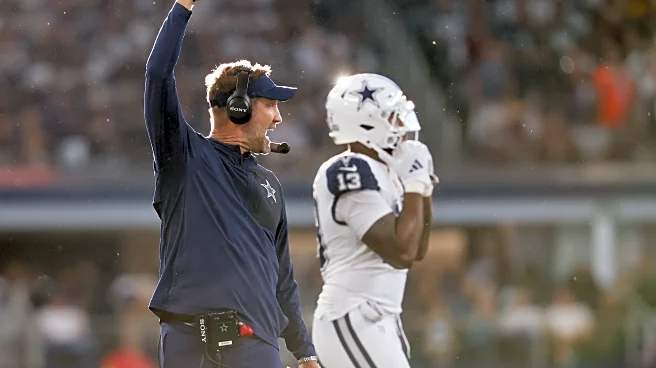What's Happening?
The 2025 NFL draft class has made a remarkable impact in the current season, with rookies achieving record-breaking performances. After seven weeks, these newcomers have accumulated an unprecedented number
of total yards and touchdowns. Notably, four rookies have scored at least five touchdowns and amassed over 500 scrimmage yards, combining rushing and receiving efforts. ESPN analyst Matt Miller highlighted the draft's focus on offensive and defensive linemen, although the standout performances have primarily come from offensive skill players. Among the rookies, Tyler Warren, selected 14th overall by the Indianapolis Colts, has excelled with more receiving yards than any other tight end, contributing to the Colts' impressive 6-1 record.
Why It's Important?
The exceptional performance of the 2025 NFL rookies is significant for several reasons. It underscores the effectiveness of the draft process and the readiness of new players to transition into professional football. This influx of talent can reshape team dynamics and strategies, offering fresh opportunities for franchises to excel. The success of rookies like Tyler Warren not only boosts team performance but also enhances fan engagement and league competitiveness. As these players continue to develop, they may become pivotal figures in their teams, influencing future draft strategies and player development programs.
What's Next?
As the season progresses, the continued performance of these rookies will be closely monitored by teams and analysts. Their ability to maintain high levels of play could lead to increased roles and responsibilities within their teams. Additionally, their success may prompt other franchises to reevaluate their scouting and drafting strategies, focusing more on skill positions. The impact of these rookies could also influence contract negotiations and salary cap considerations as teams look to retain emerging talent.
Beyond the Headlines
The rise of these rookies may have broader implications for the NFL, including potential shifts in how teams prioritize player development and training. The success of young players could encourage a greater emphasis on collegiate scouting and partnerships with college programs to ensure a steady pipeline of talent. Furthermore, the visibility and success of these rookies may inspire younger athletes, contributing to the growth and popularity of football at grassroots levels.












